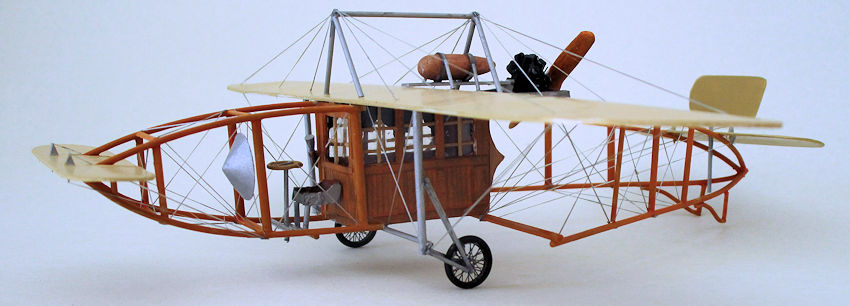
1/72 Blériot XXIV Limousine
| KIT #: | ? |
| PRICE: | $16.98 |
| DECALS: | options |
| REVIEWER: | Chris Peachment |
| NOTES: | SMade from 10 and 20 thou plastic card, with tissue paper for the curtains. |

| HISTORY |
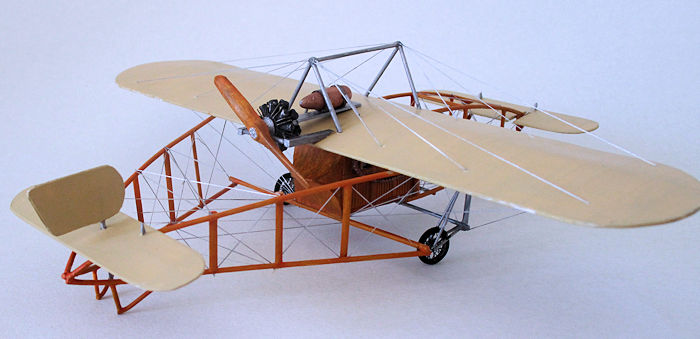 Blériot is a name that is known to all as the first man to have flown across
the English Channel, or La Manche (the sleeve) as the French call it. He did
so in order to win a Ł1,000 prize offered by the Daily Mail for the first
aircraft to fly to England from France. Interestingly, one earlier
contestant, the famous Hubert Latham, made an attempt which was not
successful, although he did enter the record books as the first man to land
an aircraft on the sea.
Blériot is a name that is known to all as the first man to have flown across
the English Channel, or La Manche (the sleeve) as the French call it. He did
so in order to win a Ł1,000 prize offered by the Daily Mail for the first
aircraft to fly to England from France. Interestingly, one earlier
contestant, the famous Hubert Latham, made an attempt which was not
successful, although he did enter the record books as the first man to land
an aircraft on the sea.
Blériot succeeded on 25 July 1909 and the headline in the next day's Daily Mail ran: “Britain no longer an island”.
I
believe that a large amount of Blériot's success must be attributable to his
magnificent moustache, carefully cultivated for maximum aerodynamic effect.
Many early aviators had moustaches too, including t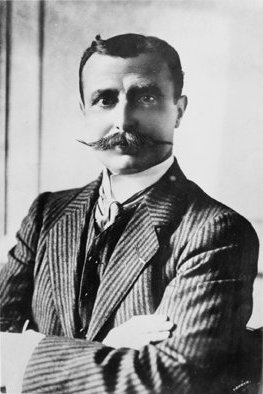 he irrepressible Esnault-Pelterie, inventor of the joystick.
he irrepressible Esnault-Pelterie, inventor of the joystick.
Blériot's mount for the attempt on the Channel was his mark IX, and he went on to design many other marks later, all of which vary, but most of which bore his trademark feature of semi-circular wingtips. This one is no different, although the fuselage is a little more busy than most.
In late 1911 Blériot produced an aircraft built to the order of Henri Deutsch de la Meurthe, the Blériot XXIV Limousine, also sometimes called the Blériot Berline, after various coach-built carriages of the day. It had an enclosed cabin with windows for the passengers, built by the Rothchild coach-building company, with the poor pilot sitting in out in front, exposed to the elements just like early car chauffeurs. In recognition of this, the designer added a small conical windshield attached to some cross wires, which was the latest thing in terms of streamlined weather proofing.
For the perfect touch, there was a speaking tube which allowed the passengers to communicate with the pilot. One can only imagine how this worked. It was presumably like an early ship's speaking tube, into which one first blew hard to set off the whistle at the other end. Then the magnate sitting inside, swathed in furs, would order the pilot to turn left at the next cloud.
 The
wings used warping for lateral control. The tail surfaces were mounted of
four wire-braced booms, and the front elevator on four curved booms attached
to the front of the cabin. It was initially powered by a 100 horsepower
Gnome 14 which was later replaced by a 140 horsepower Gnome 14 double row
engine.
The
wings used warping for lateral control. The tail surfaces were mounted of
four wire-braced booms, and the front elevator on four curved booms attached
to the front of the cabin. It was initially powered by a 100 horsepower
Gnome 14 which was later replaced by a 140 horsepower Gnome 14 double row
engine.
The aircraft was feasible, and was successfully flown at Étampes, although, instead of passengers, it carried 600 lb of ballast. Clearly M. Deutsch de la Meurthe was no fool and wasn't about to enter the record books as the first air limo fatality.
| CONSTRUCTION |
There is a side view plan on one of the websites below. It is more of a sketch but can be rejigged to scale, and gives you length and height very well. The rest of aircraft can be worked out from the very good photos.
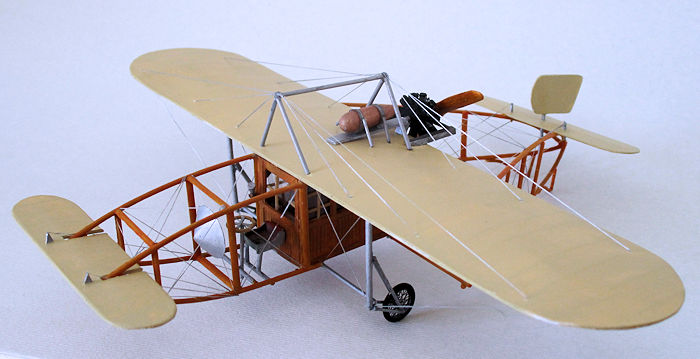 As
always with scratch built aircraft, there is a feature which you know will
be the make or break point. I usually attack this first since, if I get this
part right, then the rest will follow, and if I get it wrong, then no time
will be wasted following up a botched and abandoned attempt. Here it was the
limousine cabin for the passengers.
As
always with scratch built aircraft, there is a feature which you know will
be the make or break point. I usually attack this first since, if I get this
part right, then the rest will follow, and if I get it wrong, then no time
will be wasted following up a botched and abandoned attempt. Here it was the
limousine cabin for the passengers.
It is a simple box shape, but made from a number of layers of wood. The sides panels are slatted, and this was represented by simple scoring, which was then surrounded by ten thou card frames. The problems start with the intricacies of the windows. The frames were cut out from the walls, and the top of the frame left off temporarily. The small interior frames were then made from the thinnest rod I had, pre-painted and secured using Humbrol Clearfix very sparingly. Any clear wood glue will do, the main idea being not to scar the clear plastic. Once this was in place, then tiny curtains were cut from tissue paper, pleated and then tied in swags. I did them in a tasteful shade of blue.
The interior is largely guesswork, but must have been two wide bench
seats facing each other. The walls are covered in Empire style woven fabric
with an intricate pattern of gold fleur-de-lys, on a background of pale blue
shot silk. A mahogany card table sits between the two sets of seats, and on
it is pack of cards, showing that the last occupants were engaged in a game
of chemin de fer, with a winning hand of 9 points
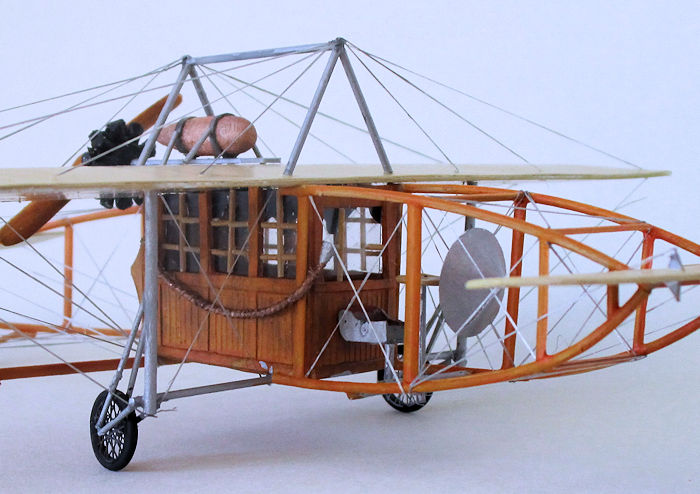 showing. There is also an
open bottle of champagne in an ice bucket. It is a shame that I cannot get
my camera close enough for any of this to be visible.
showing. There is also an
open bottle of champagne in an ice bucket. It is a shame that I cannot get
my camera close enough for any of this to be visible.
The cabin was then finished with its four curved panels coming to a pointed rear end, which was the last word in streamlining in 1911. Then, the final touch, a speaking tube was made up from carefully shaped thick copper wire, with thin wire wound around it to represent a flexible metal tube such as you find in showers. A small plastic cone was added as the earpiece for the pilot.
After that it was all over bar the shouting. Wings were done with an undersurface of 20 thou card cut to shape, a main spar of rod, fixed at one third of the chord back from the leading edge, and an upper surface of ten thou card with ribs scored underneath with a black biro. The booms were made from judiciously curved rod. The tail surfaces from 20 thou card, carefully sanded to aerofoil shape.
The rigging was done by my team of helpful spiders, given just the right amount of alcohol beforehand to boost their confidence but still leave them carefree. They were aided by elastic thread, coloured silver with a gel felt tip pen, superglue gel applied with a sharpened toothpick, sprung tweezers, strong overhead lighting, and two pairs of reading glasses on the end of my nose.
The engine mounts look like railway sleepers hammered into the upper
wing. They support a double row radial engine, which is two old engines from
my Big Bag of En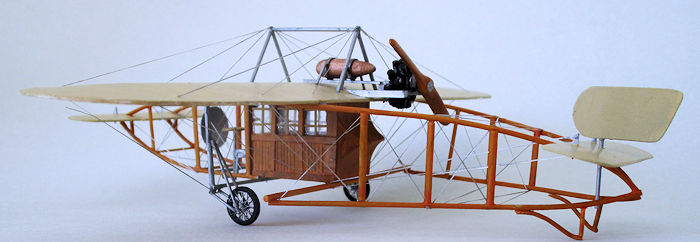 gines, glued back to back. In fact, double row radials
usually shared a common crankcase, with the rear cylinders only a small
distance back from the front row. In 1/72 terms this would be about 2mm. An
expert in white overalls crawling all over it with a micrometer would point
out that this is too much over scale here. Which is why my chauffeur has
orders to shoot experten on sight.
gines, glued back to back. In fact, double row radials
usually shared a common crankcase, with the rear cylinders only a small
distance back from the front row. In 1/72 terms this would be about 2mm. An
expert in white overalls crawling all over it with a micrometer would point
out that this is too much over scale here. Which is why my chauffeur has
orders to shoot experten on sight.
In front of the engine is a base plate to support the fuel tank, which is thick sprue, sanded to shape and painted copper, with a couple of thin straps to hold it down. The kingposts above are simply rod cut to length. The undercarriage was rod again, the wheels from Eduard's excellent etched wheel sets.
A prop was found in the Bag of Dead Props, cut down a little, painted wood with a clear orange coat, and mounted at ten to four. The pilot's seat came from the Big Bag of Seats, and his control column has a small steering wheel mounted on it horizontally. That was made from solder wrapped around a paint brush, and some spokes from scrap. For a finishing touch, his dashing windscreen was formed from a paper circle with a pie slice cut out of it, folded to a cone, and painted silver. I am sure he felt very cozy, protected from the rain and sleet driving into his face at 80mph.
| CONCLUSIONS |
The word Limousine derives from the inhabitants of the Limousin region
in France, who used to protect themselves from the incessant rain with a special
wide hat, often combined with a cloak. In coach building terms that only applies
to the passengers in the vehicle, since they were the ones with a roof. The poor
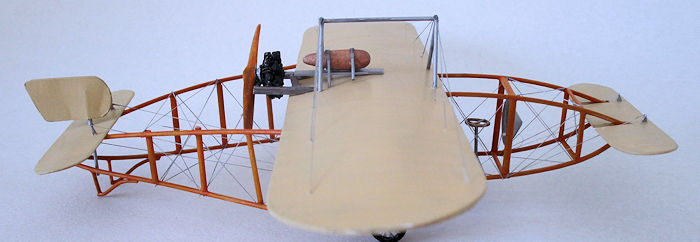 chauffeur was always left hanging in the breeze. Quite why Americans call them
limos is a mystery. A limou would more appropriate.
chauffeur was always left hanging in the breeze. Quite why Americans call them
limos is a mystery. A limou would more appropriate.
Still, there it is, one of M. Blériot's less successful ventures, which at least flew and suggested that the rich could have special privileges in the air. The next time you board an airliner, and you see all the well-heeled passengers ahead of you turning left into first class, you can blame Monsieur Blériot. But you can take some consolation from the fact that at least you won't be sitting outside in the breeze.
| REFERENCES |
http://flyingmachines.ru/Site2/Crafts/Craft28603.htm
http://www.airwar.ru/enc/cw1/bleriot24.html
http://forum.keypublishing.com/showthread.php?102291-Bleriot-XXIV
December 2015
Copyright ModelingMadness.com
If you would like your product reviewed fairly and fairly quickly, please contact the editor or see other details in the Note to Contributors.